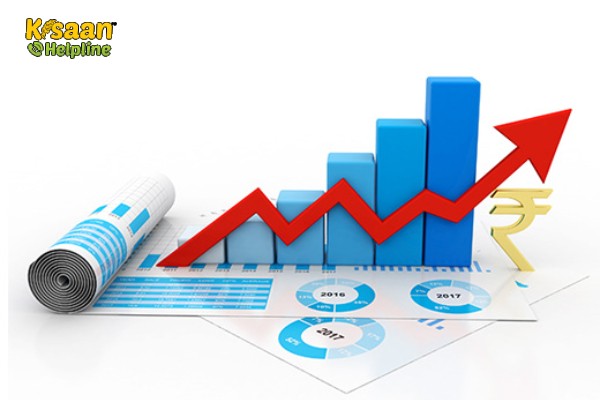
KK Singh1, Vikas Singh Sengar2 and Sanjay Dutt Gahtori2
1. Head of Department, Agril. Economics, ANDUAT, Kumarganj, Ayodhya
2. Assistant Professor, Shivalik Institute of Professional Studies, Dehradun
Economic growth is an increase in the production of goods and services over a specific period. To be most accurate, the measurement must remove the effects of inflation. Economic growth creates more profit for businesses. As a result, stock prices rise. That gives company’s capital to invest and hire more employees. As more jobs are created, incomes rise. Consumers have more money to buy additional products and services. Purchases drive higher economic growth. For this reason, all countries want positive economic growth.
How to Measure Economic Growth:
Gross domestic product is the best way to measure economic growth.
It takes into account the country's entire economic output. It includes all goods and services that businesses in the country produce for sale.
It doesn't matter whether they are sold domestically or overseas.
GDP measures final production.
It doesn't include the parts that are manufactured to make a product. It includes exports because they are produced in the country.
Imports are subtracted from economic growth.
Most countries measure economic growth each quarter:
The most accurate measurement of growth is real GDP. It removes the effects of inflation.
The GDP growth rate uses real GDP:
The World Bank uses gross national income instead of GDP to measure growth.
It includes income sent back by citizens who are working overseas. It's a critical source of income for many emerging market countries like Mexico. Comparisons of GDP by country will understate the size of these countries' economies.
GDP doesn't include unpaid services.
It leaves out child care, unpaid volunteer work, or illegal black-market activities. It doesn't count the environmental costs.
For example, the price of plastic is cheap because it doesn't include the cost of disposal. As a result, GDP doesn't measure how these costs impact the well-being of society.
A country will improve its standard of living when it factors in environmental costs. A society only measures what it values.
Similarly, societies only value what they measure. For example, Nordic countries rank high in the World Economic Forum's Global Competitiveness Report. Their budgets focus on the drivers of economic growth.
These are world-class education, social programs, and a high standard of living. These factors create a skilled and motivated workforce.
These countries have a high tax rate. But they use the revenues to invest in the long-term building blocks of economic growth. Riane Eisler's book, “The Real Wealth of Nations,” proposes changes to the U.S. economic system by giving value to activities at the individual, societal, and environmental levels.
This economic policy contrasts with that of the United States. It uses debt to finance short-term growth through boosting consumer and military spending. That's because these activities do show up in GDP.
The Phases of Economic Growth
Analysts watch economic growth to discover what stage of the business cycle the economy is in.
The best phase is expansion.
This is when the economy is growing in a sustainable fashion.
If growth is too far beyond a healthy growth rate, it overheats. That creates an asset is what happened to the housing sector in 2005-2006. As too much money chases too few goods and services, inflation kicks in. This is the "peak" phase in the business cycle.
At some point, confidence in economic growth dissipates.
When more people sell than buy, the economy contracts. When that phase of the business cycle continues, it becomes a recession. An economic depression is a recession that lasts for a decade. The only time this happened was during the Great Depression of 1929.
Ways to Spur Economic Growth:
If a country is not blessed with the factors of production, it must find other ways to spur growth.
Governments want to increase growth because it increases tax revenue. Growth allows businesses to hire workers, increasing their income.
When people feel prosperous, they reward political leaders by re-electing them.
The government stimulates growth with expansive fiscal policy. It either spends more, cuts taxes, or both.
Since politicians want to get re-elected, they use expansive fiscal policy to stimulate the economy.
But expansive fiscal policy is addictive. If the government keeps spending more and taxing less, it leads to deficit spending. It works for a while, but eventually leads to higher debt levels. In time, as the debt-to-GDP ratio approaches 100 percent, it slows economic growth. Foreign investors stop investing funds in a country with a high debt ratio. They worry they won't get repaid or that the money will be worth less.
Governments should then be careful with expansive fiscal policy. They should only use it when the economy is in contraction or recession. When the economy is growing, its leaders should cut back spending and raise taxes. This conservative fiscal policy ensures that the economic growth will remain sustainable.
A nation's central bank can also spur growth with monetary policy. It can increase the money supply by lower interest rates. Banks make loans for auto, school, and homes less expensive.
They also reduce credit card interest rates. All of these boost consumer spending and economic growth.
Economic Development
A country’s economic development is usually indicated by an increase in citizens’ quality of life.
‘Quality of life’ is often measured using the Human Development Index, which is an economic model that considers intrinsic personal factors not considered in economic growth, such as literacy rates, life expectancy and poverty rates.
There is a discovery of new mineral/metal deposits.
Growth Occurs When:
There is an increase in the number of people in the workforce or the quality of the workforce improves.
For example, through training and education, there is an increase in capital and machinery. There is an improvement in technology.
Development Occurs When
Measures of economic development will look at:
An increase in real income per head – GDP per capita.
The increase in levels of literacy and education standards.
Improvement in the quality and availability of housing.
Improvement in levels of environmental standards.
Increased life expectancy
Difference between Economic Growth and Economic Development
We can also have a situation where there is growth and development, i.e. increase in luxury goods and education.
Development alleviates people from low standards of living into proper employment with suitable shelter.
Economic Growth does not take into account the depletion of natural resources, which might lead to pollution, congestion & disease.
Development, however, is concerned with sustainability, which means meeting the needs of the present without compromising future needs.
The Relationship between Inequality and Economic Growth:
Poverty has come down most when inequality has fallen, and there is high economic growth.
Initial low levels of inequality are associated with more negative elasticity’s of poverty reduction concerning growth.
Higher initial inequality results in less effect on poverty with an increase in economic growth.
Savings rate:
The marginal savings rate changes with decreasing or increasing income.
The marginal savings rate is the fractional decrease in saving that result from a decrease in income.
Credit market constraints
The poor can’t get loans.
Political economy
Governments pursue poor policies (redistribution policies) trying to reduce inequality, which results in high inflation, high deficit, and lower growth.
However, there doesn’t seem to any relationship between inequality and economic growth empirically.
But, higher economic growth leads to lower levels of poverty (not the same as inequality)
Growth Effect
The positive growth of people’s income and no change in income leads to a decrease in the poverty level.
Redistribution Effect: If there is a rise in inequality and mean income remains constant, then poverty will rise.
Theories of Economic Growth
Different models of economic growth stress alternative causes of economic growth. The principal theories of economic growth include:
Mercantilism – Wealth of a nation determined by accumulation of gold and running trade surplus
Classical theory – Adam Smith placed emphasis on the role of increasing returns to scale (economies of scale/specialization)
Neo-classical-theory – Growth based on supply-side factors such as: labour productivity, size of the workforce, factor inputs.
Endogenous growth theories – Rate of economic growth strongly influenced by human capital and rate of technological innovation.
Keynesian demand-side – Keynes argued that aggregate demand could play a role in influencing economic growth in the short and medium-term. Though most growth theories ignore the role of aggregate demand, some economists argue recessions can cause hysteresis effects and lower long-term economic growth.
Limits to growth – From an environmental perspective, some argue in the very long-term economic growth will be constrained by resource degradation and global warming. This means that economic growth may come to an end – reminiscent of Malthus theories.








